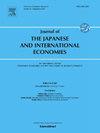Digital labor platform under the boom and bust: Bank account data insights
IF 3.1
3区 经济学
Q1 ECONOMICS
Journal of the Japanese and International Economies
Pub Date : 2025-06-04
DOI:10.1016/j.jjie.2025.101378
引用次数: 0
Abstract
This study uses deidentified bank data from a Japanese megabank to analyze how the economic downturn affected labor supply in the platform economy. Specifically, we identify gig workers based on deposit information from food delivery platform services and examine changes in their labor supply before and after the pandemic. Individuals who take on food delivery gig work typically exhibit three characteristics: they are predominantly young, male, and have low liquidity. About 32 percent of these workers had liquidity below zero, excluding gig income, and 27 % had liquidity below 50,000 yen (approximately 335 USD), indicating that many face severe liquidity constraints. Additionally, liquidity tends to gradually decline in the months leading up to gig work. While there is an increased probability of entering the gig market, the likelihood of workers staying drops to 60–70 % in the first month, suggesting the gig market serves mainly as a temporary income-smoothing mechanism. Interestingly, the average liquidity balance in the first month for those who started gig work during the COVID-19 recession was higher than for those who began gig work during the pre-pandemic boom. In addition, the decline in liquidity before starting gig work was smaller during the COVID-19 recession compared to the pre-COVID boom. Although it was expected that participation during the downturn would be driven by those facing liquidity constraints, the data shows that even individuals with some financial leeway entered the gig market during recessions.
盛衰下的数字劳动力平台:银行账户数据洞察
本研究使用日本大型银行的未识别银行数据来分析经济衰退如何影响平台经济中的劳动力供给。具体来说,我们根据外卖平台服务的押金信息识别零工,并研究他们在疫情前后的劳动力供应变化。从事送餐零工的人通常表现出三个特征:他们主要是年轻人、男性,流动性较低。除去零工收入,这些工人中约32%的流动性低于零,27%的流动性低于5万日元(约335美元),这表明许多人面临严重的流动性限制。此外,在零工前的几个月,流动性往往会逐渐下降。虽然进入零工市场的可能性增加了,但在第一个月,工人留下来的可能性降至60 - 70%,这表明零工市场主要是一种临时的收入平滑机制。有趣的是,在COVID-19衰退期间开始零工的人第一个月的平均流动性余额高于在大流行前繁荣时期开始零工的人。此外,在2019冠状病毒病衰退期间,与新冠病毒病前的繁荣相比,零工开工前的流动性下降幅度较小。尽管人们预计,在经济衰退期间,那些面临流动性限制的人将推动参与零工市场,但数据显示,即使是拥有一定财务自由度的个人,也会在经济衰退期间进入零工市场。
本文章由计算机程序翻译,如有差异,请以英文原文为准。
求助全文
约1分钟内获得全文
求助全文
来源期刊
CiteScore
5.10
自引率
6.90%
发文量
36
期刊介绍:
The Journal of the Japanese and International Economies publishes original reports of research devoted to academic analyses of the Japanese economy and its interdependence on other national economies. The Journal also features articles that present related theoretical, empirical, and comparative analyses with their policy implications. Book reviews are also published.

 求助内容:
求助内容: 应助结果提醒方式:
应助结果提醒方式:


